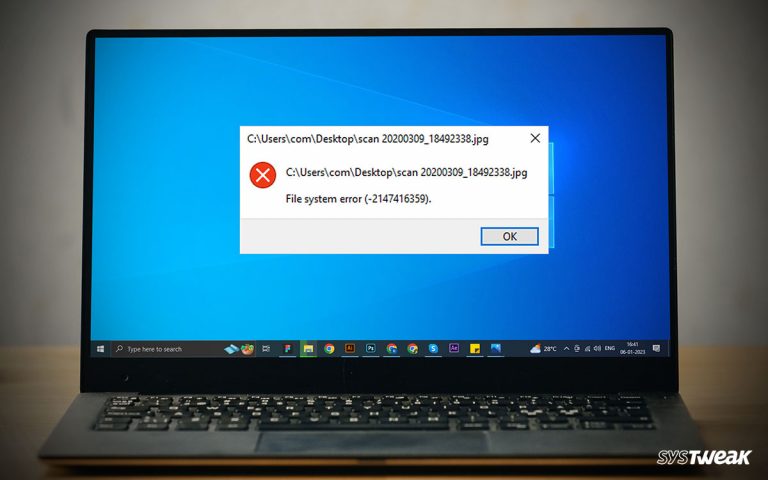Windows Registry is a vital part of Windows. It stores all the tweaks to customize your Windows experience. But as we use the system, the registry gets cluttered and declines the PC’s performance. This makes optimizing and cleaning invalid registry entries important.
50% OFF

BLACK FRIDAY OFFERS
Unlock Black Friday Mega Savings — Systweak Tools FLAT 50% OFF!
Therefore, to help with optimizing the registry on Windows 10 here, we are with a guide that will explain how to optimize the Windows registry.
What is Windows Registry?
Windows Registry stores all the information related to the configurations and settings of the operating system. It has two basic components – keys and values.
Keys are further divided into hundreds of subkeys, indicating the path names appearing in the screen’s left panel in the hierarchical order. Each key and subkey stores values that further contain instructions for the operating system. Values appear in the right panel of the screen.
Windows Registry consists of hives that are Registry keys topping the order in the hierarchy. Keys representing Hives start with HKEY and comprise a set of subkeys and values. Generally, the Registry contains 6 hives.
With constant use, as the hard disk gets fragmented the same way as we install and uninstall apps, the registry gets fragmented. Moreover, the unwanted entry deleted from the Hive creates gaps or free spaces in between and continues to remain there.
Due to this, each time a new entry is created, it is added to the end of the queue without disturbing the existing queue of entries. Eventually, this grows Registry size and increases system access time, making the system act sluggish. In such a scenario, optimizing the registry in Windows 10 becomes essential.
Again, defragmentation cannot be done manually. To perform this task, we need a reliable registry optimizer. For this, we can try Registry Optimizer offered by Advanced System Optimizer.
Download Advanced System Optimizer
What does Registry Optimizer do?

Registry Optimizer helps defrag Registry in simple steps. It locates all the entries which are meant to be placed one after the other in the Registry but are scattered.
Under the defragmentation process, the entries are linearly placed, gaps produced by the removal of invalid entries are removed and a new compact Registry is created.
The compact Registry so formed is structured linearly, systematic, and error-free. System access time shows improvement and so does the performance.
The job looks quite tedious and cumbersome, but the user finds this tool very simple to use and understand and thus optimizes the Registry without taking much pain.
Read Also: How To Clean Invalid Registry Entries on Windows – 10
How To Optimize Windows Registry Using Registry Optimizer
To make Windows work smoothly and consistently, the registry should be kept streamlined. But with random installations and uninstallation, the Registry keeps on fragmenting.
Using this user-friendly Registry Optimizer in no time you can optimize the registry on Windows 10. Here’s how to use it.
Scan Tab
The defragmentation and optimization process has been divided into 5 steps:

Step1: Welcome
Step2: Scan
Step3: Results
Step4: Restart System
Step5: Summary
Step1: Welcome
The registry is an inevitable part of Windows and Windows works on the basis of this huge database i.e., Registry. With constant installations/uninstallations and additions/deletions, the Registry gets fragmented.
When a program is uninstalled its corresponding Registry entries are not always deleted, this leaves behind traces as invalid entries in the Hive.
Even when the junk or obsolete data is deleted permanently from the Hive, the size of the Hive doesn’t reduce and remains constant.
Removal of unwanted data between various Registry entries creates gaps or free spaces thus fragmenting the Registry. As time goes by the Registry gets further fragmented and causes many system-related problems.
To initiate the scan, you need to click on the “Start Scan Now” button in the middle. In the next step, the Registry is analyzed to find out the volume of fragmentation existing in it.
Step2: Scan

The entire Windows Registry is scanned. Each section of the Registry is critically analyzed to check for fragments. During the analysis, the PC might not react or respond.
Step3: Results

The moment the analysis is complete, a detailed scan report is shown with the percentage of fragmentation. The next step is the optimization process.
Step4: Restart System
On clicking the “Optimize Now” button, the process of Registry defragmentation starts. The programs in current use should be saved and closed before the optimization starts.
During the defragmentation process, the system requires a restart. This happens because a new and compact Registry is created for Windows. The old and fragmented Registry is replaced by the new, compact, and error-free Registry. If you agree to go for a restart, please click “OK” or click “Cancel” to skip the operation of optimization.
Step5: Summary
An Optimization Summary is presented after the optimization process is through. The summary shows the number of registry keys optimized and most importantly, the size of the Registry before and after optimization is compared.
This helps to give a fair idea to the user that how much has defragmentation helped to reduce the size of the Registry.
Schedule Tab

You may set the time to optimize the registry of the scan by using the various options given.
Options to schedule scan:
“Every Day”
OR
“Run Once”
OR
“Every Week”
OR
“Do Not Schedule” scan (undo the scheduled scans)
This is all using these simple steps you can optimize the registry on Windows 10. We hope we were able to answer how to optimize the Windows registry. In case you have any questions or doubts regarding the product feel free to contact the support team at support@systweak.com.
Recommended :
Disk Defragmenter on Windows 7 Not Working, Here’s What to do!
Workable Ways to Fix – Your Computer Is Low on Memory in Windows 11/10





